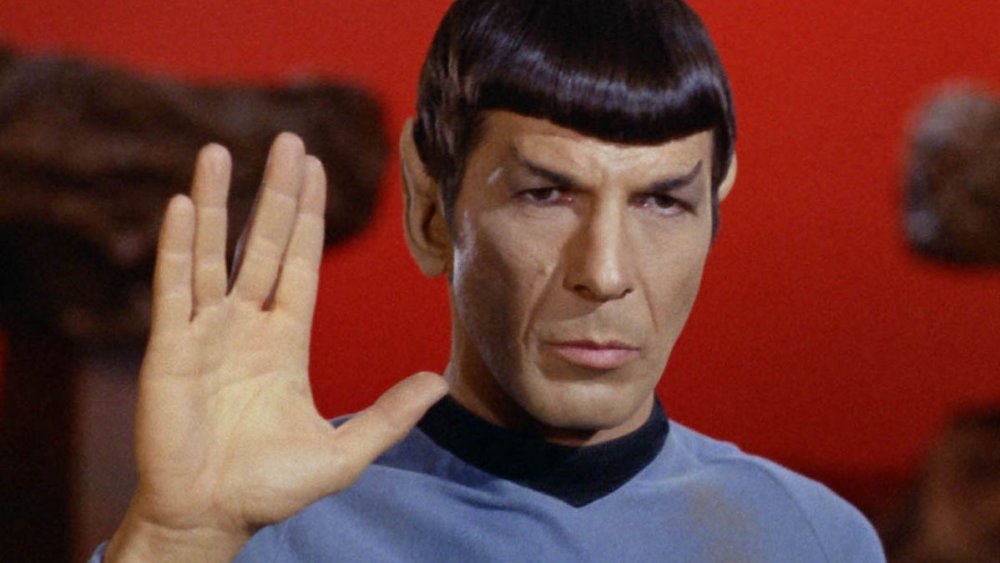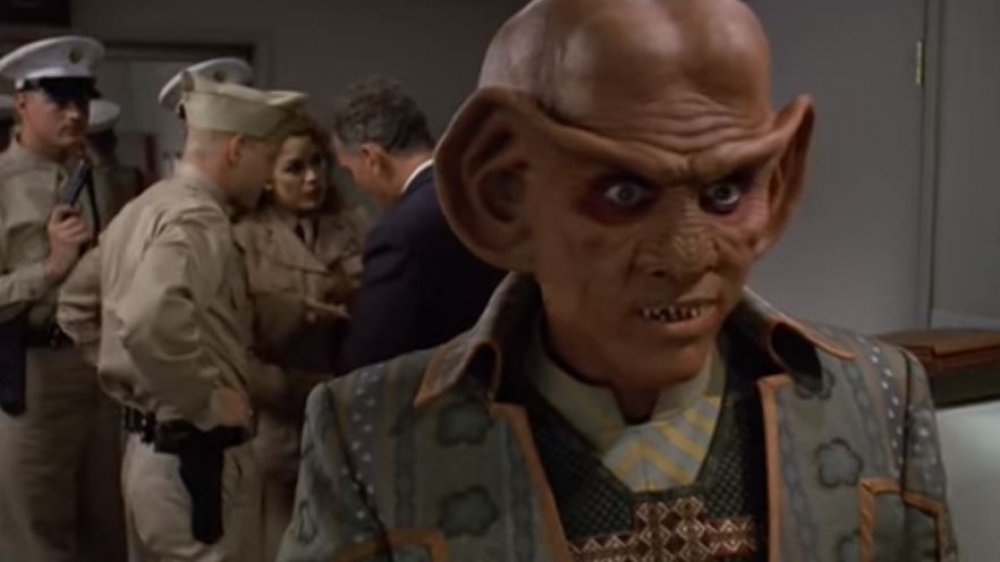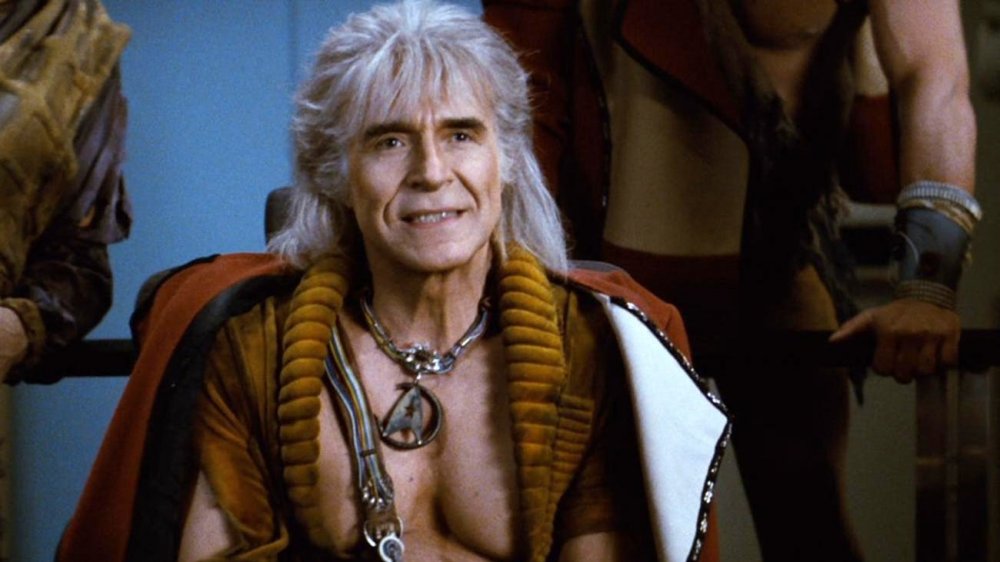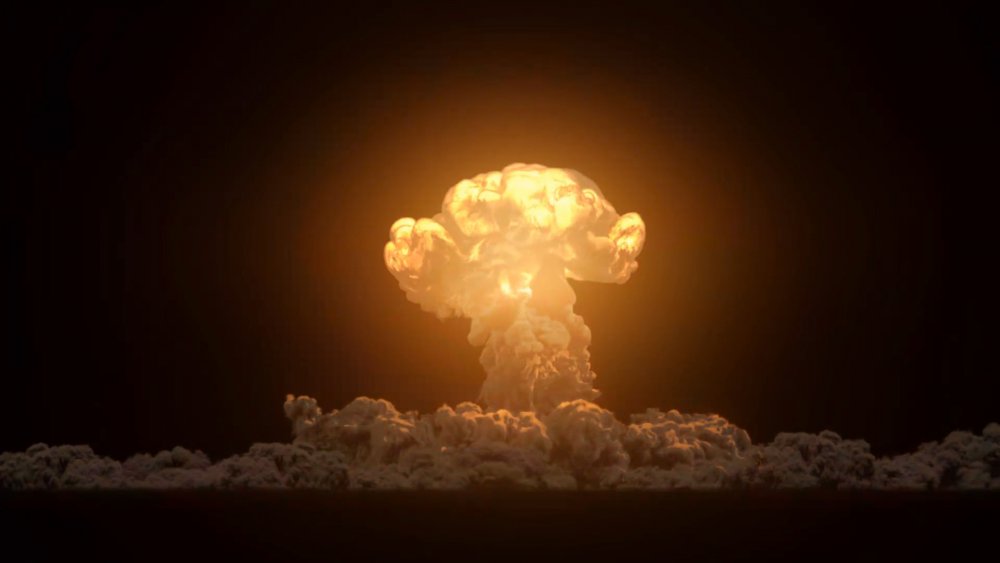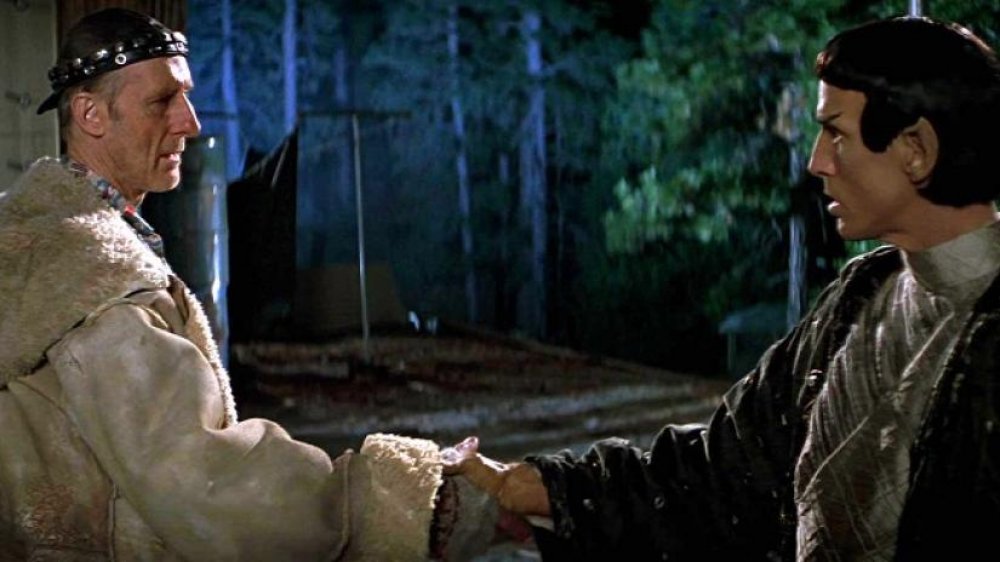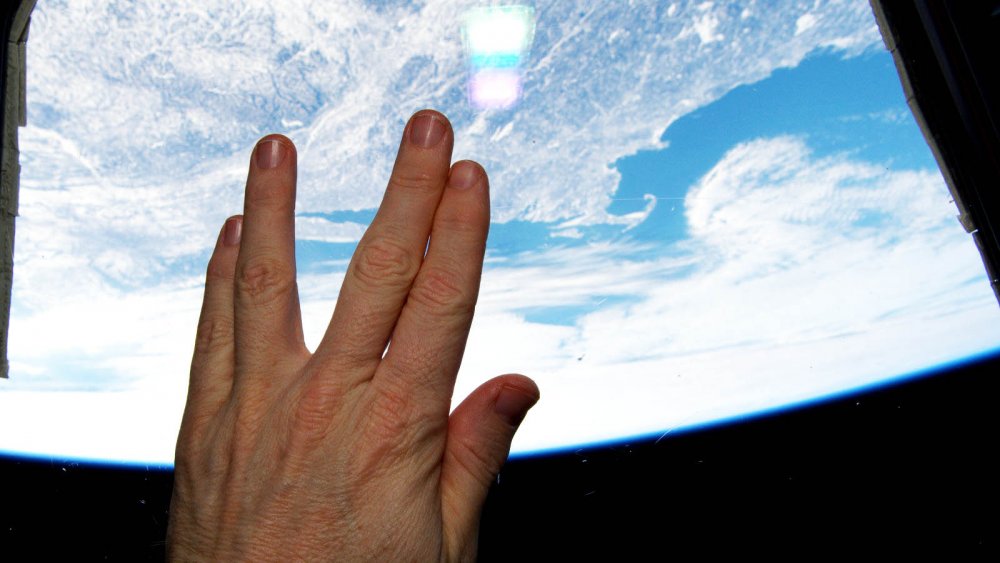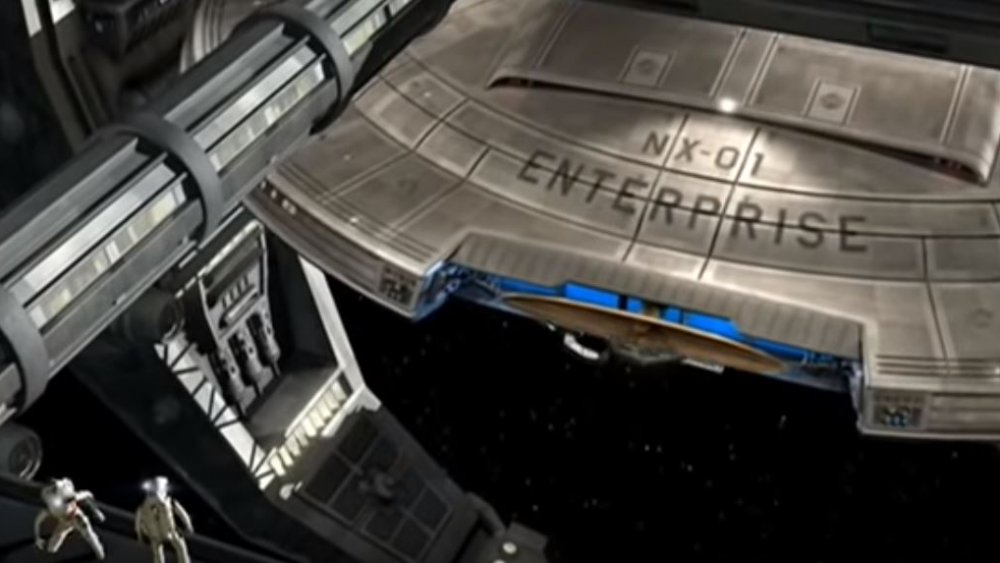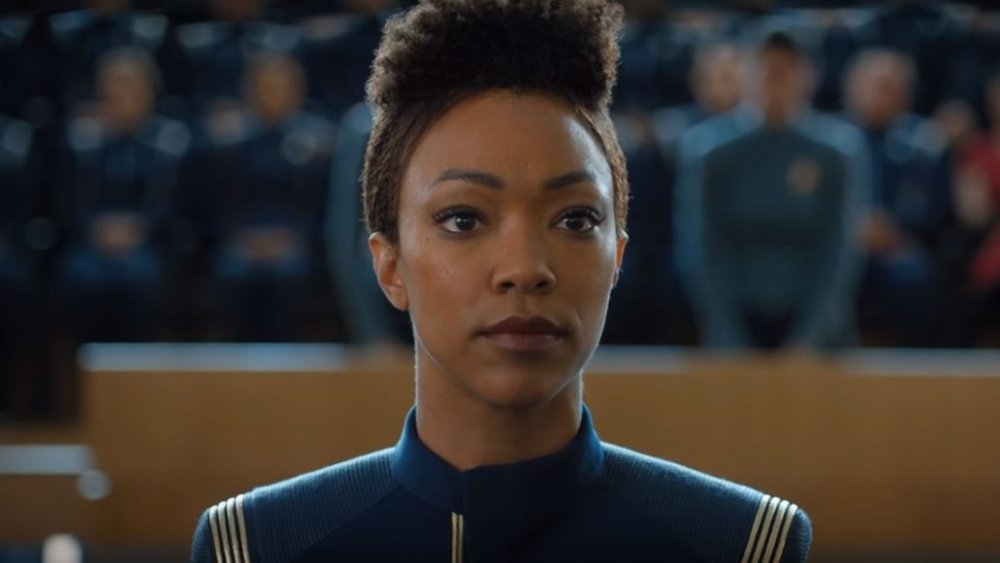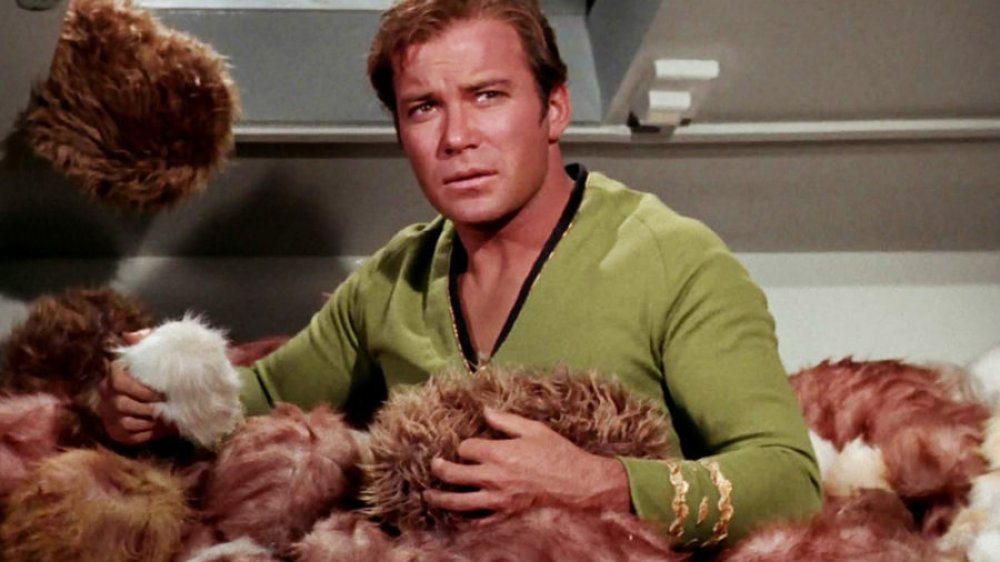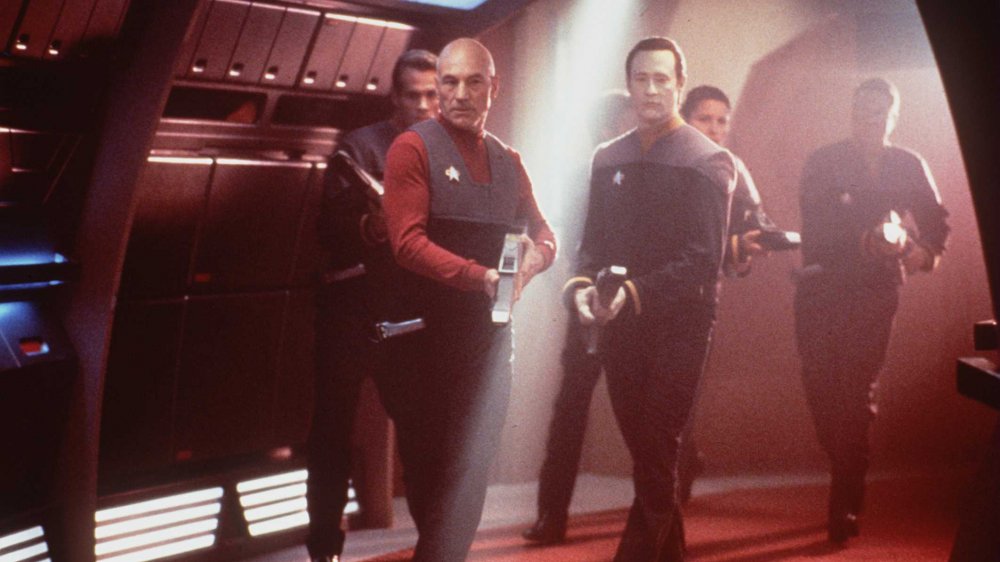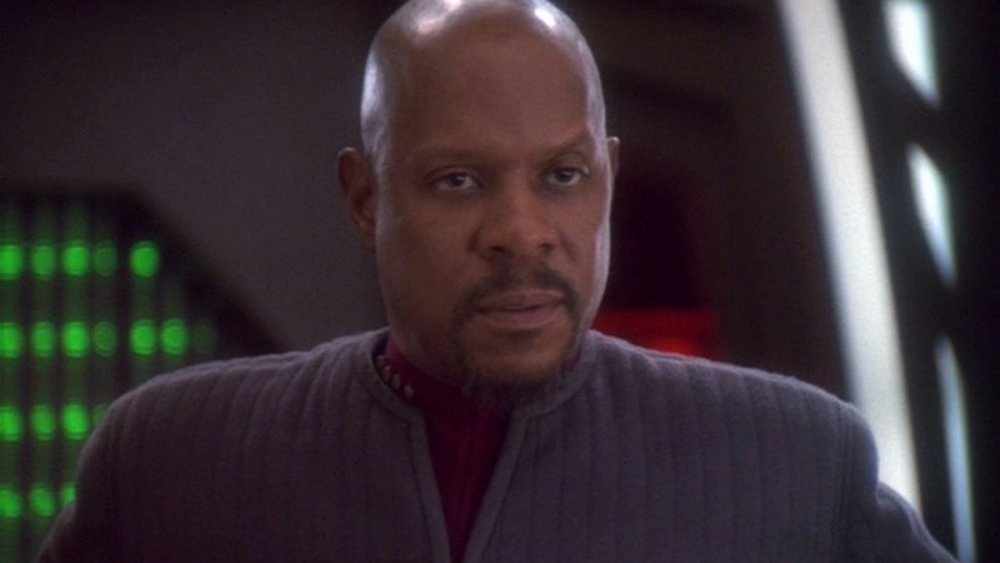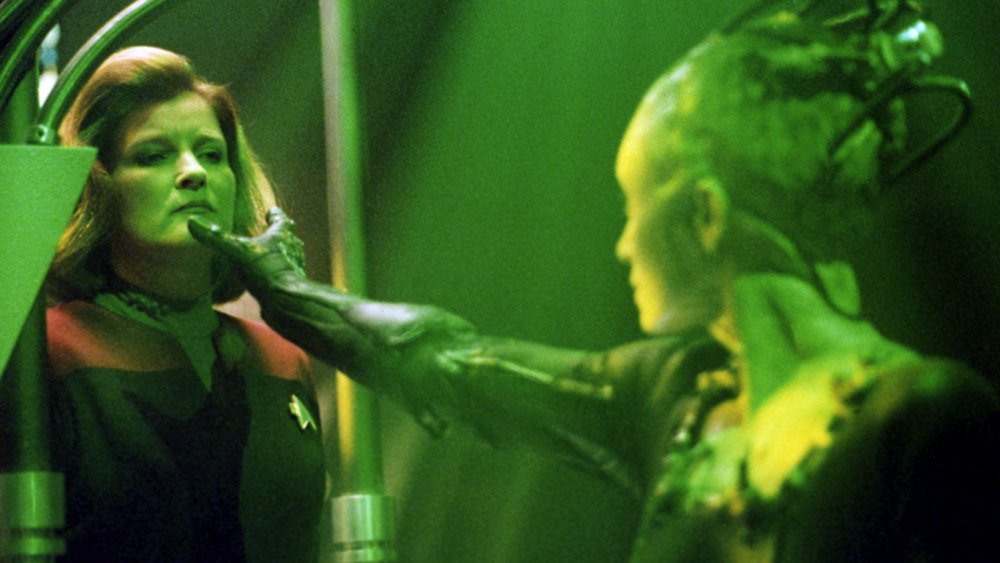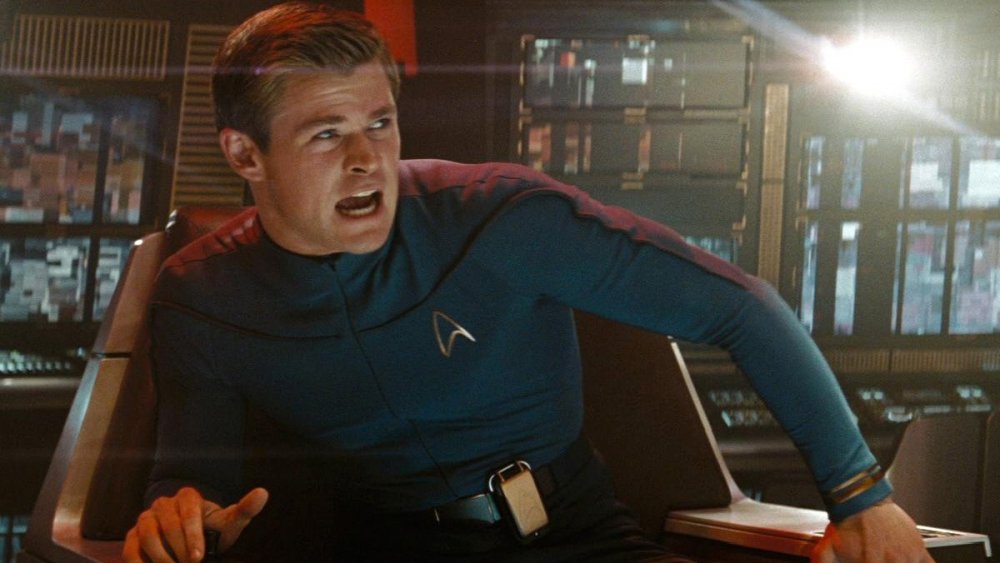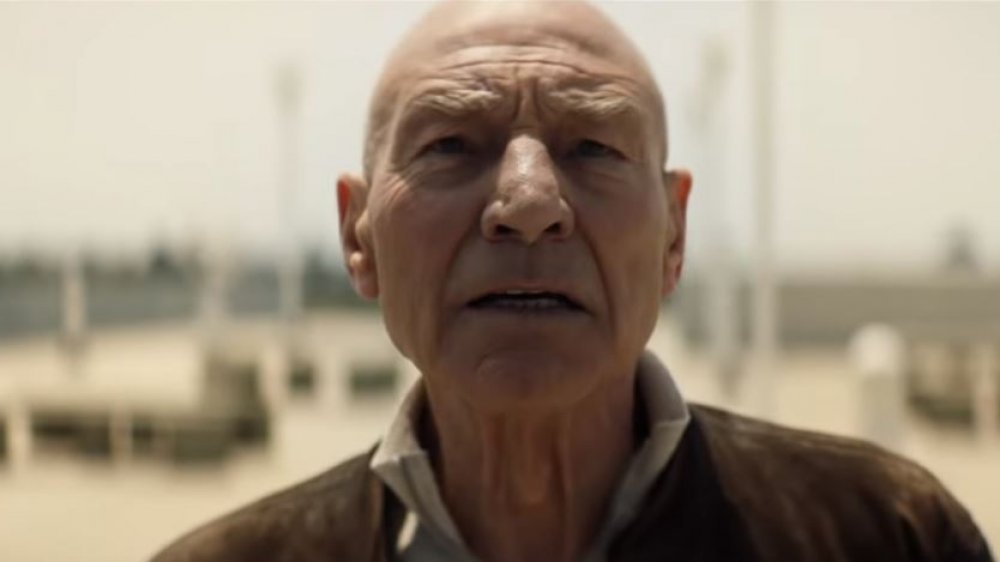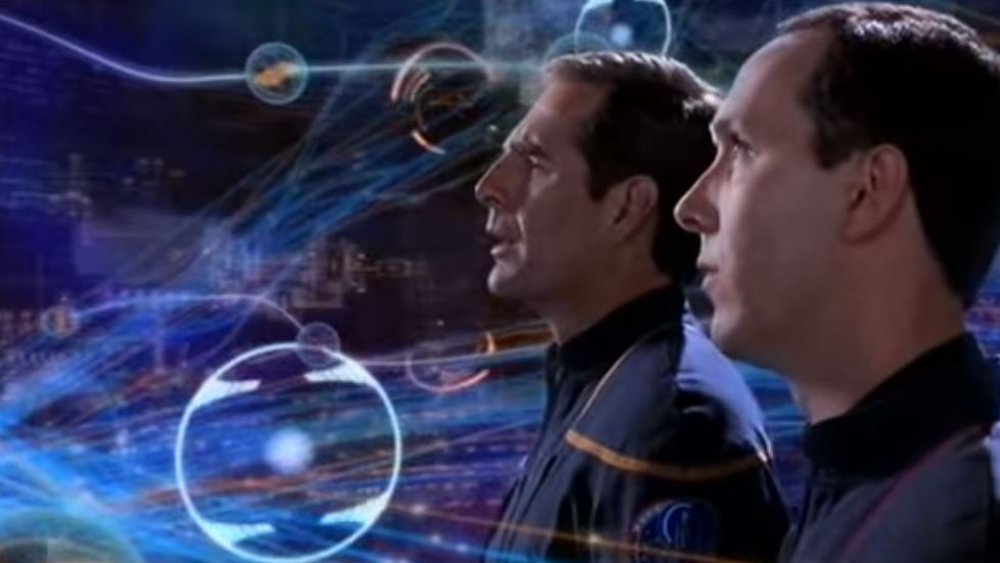The Entire Star Trek Timeline Explained
Star Trek isn't just a popular media franchise — it's a philosophy of life. Back in the '60s, when Gene Roddenberry first set loose Kirk, Spock, and Uhura upon the world, the utopian vision he spearheaded was a breath of fresh air. On the bridge of the Enterprise, people of different races, backgrounds, and genders stood together, surrounded by advanced technology, and united in a shared mission. Star Trek wasn't intended to be an idealistic fairy tale, but rather, an illustration of humankind's potential.
Then ... decades went on, different creators got involved, and the story got complicated. While many casual fans would love to get more invested in Trek lore, it's hard to figure out where to start, much less which order to watch all the shows in. That said, just because something is messy doesn't mean it's not also amazing, and Star Trek is worth your effort. Here's a thorough guide through the Star Trek timeline.
Looking back at the past
Buckle up, because the complete Star Trek saga begins not in the distant future, but in the recent past. Why? Because time travel is a pain in the neck, that's why. As Trek tells it, some significant historical events of the 20th century may be the result of time-traveling shenanigans. The most notable interference occurs in the Deep Space Nine episode "Little Green Men," which depicts a small group of Ferengi — those are the money-obsessed dudes with the big ears — accidentally getting slung back into Earth's past, in the year 1947, where they cause the infamous Roswell Incident. Oops.
To be fair, Starfleet officers usually try to be more careful about mucking up the past, as seen in the classic episode "Tomorrow is Yesterday." Here, Kirk's Enterprise is hurled back to the year 1969 and sighted by the Air Force, who believe it's a UFO. Hey, that's not inaccurate. The crew spend the episode going to massive lengths to avoid any further damage to the timeline, like the good Samaritans they are, but at least one 20th-century fella walks away knowing that humankind will become crazy awesome in the future.
The 1990s are ... well, confusing
These days, while some die-hard Trekkers still hold firm to the idea that Star Trek takes place in "our future," it's increasingly hard to see the franchise as existing in anything other than an alternate timeline. Khan, as played by Ricardo Montalbán, presents a divergence that's especially hard to rectify. He's a warlord from a so-called "Eugenics War" that ravaged Earth in the 1990s, wherein genetically altered tyrants like him apparently waged brutal battles and enslaved entire populations. Khan, in particular, is said to have ruled over one-quarter of Earthlings.
Dolly the Sheep, Bill Clinton, the World Wide Web ... a lot of things happened in the '90s, but super-powered warlords weren't one of them. Sorry.
That said, Trek fans are notoriously stringent about their timeline, so later writers have gone to great lengths to ensure that the Eugenics Wars stays fixed in place. According to Memory Alpha, the outright war hinted at in the original series has been re-framed as a covert, secretive affair that was probably linked to real-life battles in the '90s. Hey, fair enough. That said, if you're thinking that everything starts getting clean, utopian, and Trek-like after the Eugenics War is kaput, think again.
The outbreak of World War III
Eventually, humans in the Star Trek universe learn to get along, ditch money, and be cool with everybody from every background. However, the process of getting here required a massive conflict to remind everyone just how much war sucks. That conflict, fittingly enough, is named World War III. If you though the past two World Wars were too long, well, Screen Rant says that the third edition dragged on (and on, and on) from 2026 until 2053, with countless nuclear bombs being dropped, major governments getting toppled, and other nightmarish happenings of the sort that John Titor once warned the internet about. Allegedly, eugenics played some role in these battles, too.
While World War III wouldn't be the last war in galactic history, it was the final one ever waged between Earthling factions, on Earth's surface, with no extraterrestrial involvement. After nearly three decades of gunfire, Earth's remaining powers met for a truce in San Francisco, and society finally got a chance to rebuild.
First contact in the Star Trek timeline
If your head is already spinning, don't worry. Things get a bit more "Star Trekky" from this point forward.
In a narrative sense, the true "launch date" of the Star Trek story begins in the year 2063, as depicted in Star Trek: First Contact. At this time, the world is still ailing and poverty-stricken thanks to all that nuclear warfare, but humankind is inching toward the stars again. The leader of these efforts is the eccentric scientist Dr. Zefram Cochrane, who not only has the coolest name ever, but manages to invent Earth's first manned, warp-drive ship. Fittingly enough, considering all the BS that humanity just survived, he dubs his starcraft "the Phoenix."
Anyhow, when the Phoenix warps out into space, it's detected by the Vulcans. Those good, pointy-eared, logical folks decide that, thanks to this grand technological achievement, the time has finally come for humankind to publicly meet beings from another world. And so, the Vulcans zoom down to Earth, the Earthlings finally get over their whole "do aliens exist?" question, and the road to a brighter future is paved.
Vulcans steer humans toward utopia
Thankfully, Star Trek wasn't created by Tim Burton or Ed Wood, so the Vulcans turn out to be authentic buddies instead of carnivorous lizard creatures, space blobs, or what have you. Over the next century, according to Screen Rant, the Vulcans become humanity's trusted advisers into the stars, slowly training the Earthlings on how to be a more advanced species, and not just by sharing their cool gizmos, but by eliminating all of Earth's poverty, ditching money, healing all those nasty diseases, and easing worldwide tensions. Thanks to all this alien help, Earth eventually unites under a United Earth Government.
Now, by this point, it should be clear that even if Vulcans are a bit stiff, they make some seriously cool allies. That said, even after Vulcans spend a century just helping Earth out, not everyone is so hot on them. As explained by StarTrek.com, some people are resentful of the fact that Vulcans only very slowly tease out their various scientific advancements, instead of sharing it all in one go. You know, as if humanity didn't just spend 30 years blowing itself to smithereens.
The Enterprise is born
In the 2130s, according to Memory Alpha, the utopian city of San Francisco gives birth to Starfleet, a space organization that aims to, as famously proclaimed by Zefram Cochrane, "seek out new life and new civilizations. To boldly go where no one has gone before."
To make this dream a reality, Starfleet builds humanity's first Warp-5 vessel in 2151, the Enterprise NX-01. The world's first Enterprise is commanded by a dude named Dr. Sam Beckett ... er, sorry, Jonathan Archer, who leads a quirky crew of humans, a Vulcan, and even a Denobulan across the galaxy for the next handful of years, as depicted in the series Star Trek: Enterprise. Because dramatic tension requires big problems, Archer's crew eventually gets embroiled in a war against some animalistic aliens known as the Xindi. Unfortunately, this is followed just a few years later (off-screen) by a war against the Romulans. Remember that latter group, as they're the ones who seem like perpetually ticked-off Vulcans.
Once the dust settles on all this intergalactic warfare, the year 2161 sees the Earthlings, Vulcans, Andorians (the blue dudes), and the Tellarites do a big pow-wow back in San Francisco, where they form the United Federation of Planets. It's a cool organization, which the rest of Star Trek history pretty much centers on.
Enter Star Trek: Discovery
At this point, you arrive at the prequel series Star Trek: Discovery, which according to Den of Geek is set around the year 2255 — basically, about a decade before the original 1966 series. By this point, the Federation has been batting around for a century. Things are going swell, for the most part, other than the fact that everybody's now embroiled in a long-running Cold War with the Klingons. The series itself follows Michael Burnham, a human Vulcan specialist played by Sonequa Martin-Green, who serves aboard the science vessel the U.S.S. Discovery. Hence, the series name. Voila!
Now, the fact that a futuristic sci-fi show produced in 2017 is supposed to be a prequel to a series from the '60s presents some obvious challenges, particularly regarding the fact that any advanced tech in Discovery seems radically more advanced than the stuff in the original Gene Roddenberry series. How to explain it? Well, aside from the fact that the Discovery is a science vessel, Screen Rant points out that the series has gone to great lengths to establish that the 1966 show's dated aesthetics are due to the influence of Enterprise Captain Christopher Pike, an old-fashioned dude who prefers old-fashioned tech. While not spelled outright, it can be assumed that Pike — first introduced in the 1966 show's pilot, "The Cage" — probably passed down his dated preferences to Kirk.
Say hello to the original series
As should be clear by now, Star Trek has a lot of prequels. Finally, though, this brings the picture to the years 2265 to 2269, where Kirk, Spock, Sulu, Bones, Uhura, Scotty, and the rest get up to the famous shenanigans depicted in the original Star Trek TV series. From here, you know the drill. We've got a five year mission, Klingon tension, a bunch of fluffy Tribbles, and battles against dinosaur-looking aliens. The Roddenberry era is, and will forever be, the heart of all things Star Trek. By this point, the human race has evolved way beyond all the quarrels that were still going on in the Enterprise era, but they still aren't quite at Next Generation-level perfection.
Star Trek: The Motion Picture, then, takes place about a decade later, in the 2270s, and depicts the now-Admiral Kirk bringing the band back together on a retrofitted Enterprise to do, well, pretty much the same things they did ten years ago. Hey, worked the first time, right? The following Star Trek movies (up until the Next Generation team takes over) all take place within the same general time frame.
Picard makes it so
Okay, so once the original crew finishes their fun, a long, long time passes between the original Star Trek movies and Star Trek: The Next Generation. The latter series takes place almost a century later in 2364, according to Digital Spy, and features a Charles Xavier-looking mofo named Captain Jean-Luc Picard taking over the U.S.S. Enterprise-D on yet another mission of exploration. By this point, the Federation is so cool with the Klingons that they even have one serving as Picard's Lieutenant (hey, Worf!), and technology has advanced to the point of producing holodecks, badge communicators, Geordi's VISOR, and so on.
Now, Captain Picard might not be as psychic as you think he is, but he's a levelheaded leader, and probably the person you most want commanding your ship if you ever encounter, say, a species of freaky cyborg aliens who fly through space in giant cubes. Speaking of those guys, they're called the Borg. Much of Next Generation deals with them nearly exterminating the Federation, trying to assimilate humanity into their ranks, and generally being the biggest threat in space history.
Meanwhile, other events are afoot ...
Deep Space Nine, reporting for duty
The approximate time period that Next Generation takes place in is accompanied by two other Star Trek shows, both of which happen in wildly different sectors of outer space. The first of these is Star Trek: Deep Space Nine, which Digital Spy charts as beginning in 2369. This cult favorite series depicts the liberation of the planet Bajor from a 50 year occupation by the militaristic, snakelike Cardassians. Once Bajor is free, the Federation moves into nearby space station Terok Nor, rechristens it Deep Space Nine (DS9), and installs Earthling Commander Benjamin Sisko to keep the peace, tamper down all the conflicts, and guide Bajorans into joining the Federation. Instead, he accidentally discovers a wormhole, talks to celestial beings known as the Prophets, and ends up being hailed by Bajorans as a religious figure named "the Emissary." Hey, life takes you in unexpected directions.
However, Sisko's heartfelt, off-the-cuff leadership style ends up being a perfect fit for DS9, particularly when the aliens on the other side of the wormhole — shape-shifting "Founders" who rule over an empire called the Dominion — get embroiled into warfare with the Federation. Yes, another war. And yes, the Federation wins, largely thanks to Sisko, though his fate ends up being rather ... well, it'll leave a tear in your eye, that's for sure. Watch and see.
Voyaging (and getting lost) in the Star Trek universe
Around this same decade, you have Star Trek: Voyager, set in 2371. This show depicts the adventures of black coffee-loving Captain Kathryn Janeway, whose U.S.S. Voyager goes on a regular cruise through the stars, only to accidentally get warped all the way to the Delta Quadrant, a region of space that's at least 75 years from Earth. Take that, Will Robinson! This puts them in a weird situation where they have no communication with the Federation, no familiarity with most of the aliens they encounter, have to team up with groups they might've normally been wary about, and worst of all, they find those Borg creeps at their throats again. Uh-oh.
As Vulture points out, another key character in Voyager is Seven of Nine, played by Jeri Ryan. She's a Borg who slowly rediscovers her humanity as a member of Janeway's crew. As for the show's final episode, it pits Captain Janeway against the Borg Queen.
What's the deal with this whole 'Kelvin' timeline thing?
If you've been racking your brain, trying to figure out where those newfangled Kirk-led Star Trek movies of the 2010s come in ... well, here's your lucky ticket: They belong to an alternate universe dubbed the "Kelvin" timeline.
In 2387 of the original "Prime" timeline, as explained by Fandom, a few decades after Next Generation ends, the whole galaxy is menaced by a deadly supernova. Sadly, the catastrophe's opening trick is to destroy the planet Romulus and everyone on it. Flying to the rescue comes an elderly Spock, who attacks the supernova with a mysterious entity called "Red Matter," and while this fixes the problem, it can't bring back Romulus. To make a bad situation worse, a Romulan miner named Nero blames Spock for the whole disaster. Nero crashes both his and Spock's ship into a black hole caused by the Red Matter, sending them back to the year 2233.
And that's where Nero, along with his ship full of angry Romulans, attacks a Federation vessel called the U.S.S. Kelvin. The ship goes down, killing first officer George Kirk on the day of his son's birth. This not only leaves future Captain James Kirk to grow up without a father, but it also creates an alternate universe (Kelvin) which spins in a different direction, while the original timeline (Prime) remains unaltered.
Picard returns
Now, until recently, this was the last word on the 2300s. The fate of any characters in Next Generation, Deep Space Nine, and Voyager beyond their end of their respective shows was left mysterious.
Then along came Marvel's Logan, and the powers-that-be realized how much audiences love to cry at the sight of their favorite characters struggling against old age, and thus, Star Trek: Picard was greenlit. This 2020 sequel series depicts an elderly Jean-Luc Picard in the year 2399, on the cusp of the long-awaited 25th century, dealing with the fallout from the aforementioned destruction of Romulus. After nearly two decades of every Star Trek release being either a prequel or a reboot, while never diving further into the future, it seems only fitting that Roddenberry's vision of utopia will finally move to the next level — and that Admiral Picard will be the one to make it so.
The future of Star Trek?
The Star Trek timeline encompasses about 400 years of stories. It's so epic that it makes Lord of the Rings look tame in comparison. Still, one can't help but ponder, could this idealized version of humanity survive for oh, say, another 600 years?
As it happens, Star Trek has played with the notion of pushing into the 3000s for a long time. For example, Slashfilm reported that back in 2005, X-Men director Bryan Singer tried to spearhead a series titled Star Trek: Federation, which would've featured a decadent, Roman Empire-esque Federation in the year 3000. This show never got off the ground, but the canon version of the 31st century has been glimpsed at in Enterprise. According to Memory Alpha, this involved the whacked-out "Temporal Cold War," wherein different alliances tried to mess with historical events to suit their own means. Yikes, as if this stuff isn't confusing enough? Meanwhile, according to The Hollywood Reporter, the third season of Discovery also takes place in the 3000s, so this distant future may soon become a key part of Trek lore.
For now, though, that's the gist of it. Beam 'em up, Scotty.
